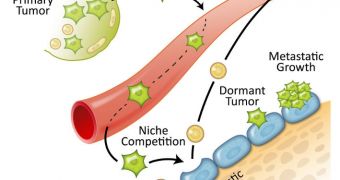Investigators from the University of Michigan say they managed to discover the reason why people who suffer from breast or prostate cancers are very likely to experience a relapse in their condition. Most often, that relapse affects the bones.
This connection has puzzled scientists for quite some time, and a lot of funds went into researching this connection. The new study finally managed to shed some light on this issue, the UM team says.
The new investigation also provided the team with additional insight into how cancer dormancy and recurrence take place. This could in the near future help oncologists find a way of ensuring cancer does not relapse after being treated once.
In the study, the UM scientists discovered that prostate cancer cells tend to attack and overrun the bone marrow niche, a specialized structure that contains hematopoietic stem cells. These precursor cells are responsible for the creation of red and white blood cells.
According to UM School of Dentistry professor Russell Taichman, the senior author of the new study, the cancer cells remain dormant once they reach this location, if the original tumor site is targeted by doctors and destroyed.
Inside the specialized niche, the dangerous cells remain dormant for years, before they are reactivated, and start developing tumors again. Only this time, the process takes place in the bones, not at the original infection site.
When experts looked inside the bone marrow of cancer patients, they discovered tumor cells and hematopoietic stem cells competing for survival at the same location. This finding implies that the niche plays a critical role in the development of bone cancer.
Past studies had demonstrated that bone cancer tends to appear about 5 years after the original prostate or breast cancer had been cured. What experts did not learn was what happened to the tumor cells during this interval.
“So what have the cancer cells been doing during those five years? Now we have a partial answer – they've been sitting in this place whose job it is to keep things from proliferating and growing,” Taichman explains.
“Our work also provides an explanation as to why current chemotherapies often fail in that once cancer cells enter the niche, most likely they stop proliferating,” adds UM expert and lead study author Yusuke Shiozawa.
“The problem is that most of the drugs we use to try to treat cancer only work on cells that are proliferating,” he concludes.
The new paper, called “Prostate Cancer Metastases Target the Hematopoietic Stem Cell Niche to Establish Footholds in Marrow,” appears in the latest online issue of the Journal of Clinical Investigation.

 14 DAY TRIAL //
14 DAY TRIAL //